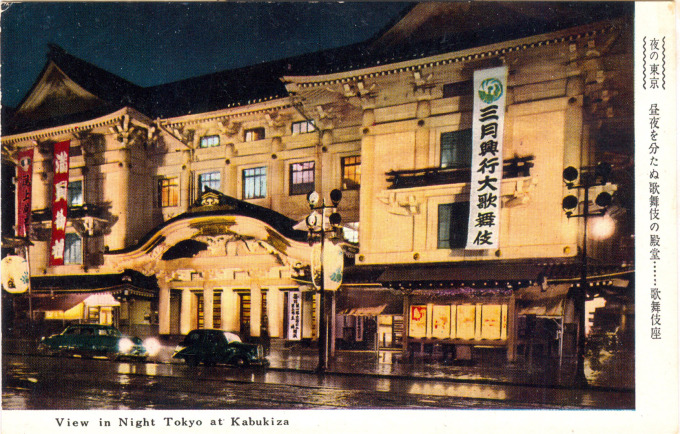
View in Night Tokyo at Kabukiza, Tokyo. The 1951 opening of the third Kabukiza, rebuilt from the post-earthquake theater that was then destroyed by wartime firebombing in 1945, marked the return of Kabuki post-war into Japanese theater and Japanese culture.
See also:
Kabuki Theatre, Tokyo, 1910-1950
Kabuki theater & Kabuki actors, c. 1910
View of the stage and interior, Kabukiza, Tokyo, c. 1960
“I was taking a stroll about the Ginza [in 1940] when I accidentally wandered into the Kabuki-za. I thought it was a temple.”
– Faubion Bowers
“Faubion Bowers is known as ‘The Man Who Saved Kabuki’ in Japan. While on his way to Indonesia in 1940, he visited Tokyo’s Kabuki-za where he watched the famous Kanadehon Chushingura [‘The Treasury of Loyal Retainers’, about the 47 ronin] kabuki play, and was very moved by kabuki as an art form. Four years later he returned to Japan as General MacArthur’s secretary during the American Occupation of Japan.
“At this time the Supreme Commander of the Allied Powers (SCAP) thought kabuki should be banned for its portrayal of feudal values. Bowers was strongly against this, stating that ‘kabuki is not only Japanese culture but world culture and must be preserved for the future.’ Bowers promoted kabuki plays and instructed that a ‘Dream Team’ cast of big kabuki stars should be assembled to perform Kanadehon Chushingura in 1947 (the same play Bowers had enjoyed watching in 1940). This performance and many others performed at the Tokyo Army College were a success, and the cast later performed the play in 1950 in East Coast venues across the United States.
“In 1985, Bowers was awarded the Order of the Sacred Treasure by the government of Japan.”
– Wikipedia


Pingback: The 47 Ronin (Genroku Ako Vendetta). | Old Tokyo
Pingback: Kabuki Theatre, Tokyo. | Old Tokyo
Pingback: Kabuki theater & Kabuki actors, c. 1910. | Old Tokyo